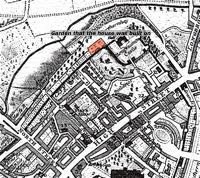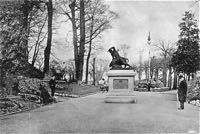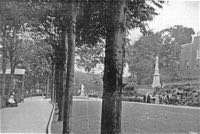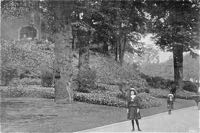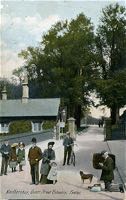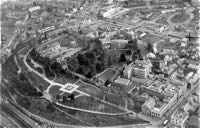
Northernhay Park and Rougemont Gardens
Page updated 3rd July 2016
 Northernhay
meaning northern enclosure, is believed
to be the oldest public park in the country, dating back as far as
1612. A map of 1617 by John Norden the Elder for Sir James Fullerton
who was the Surveyor of the Lands and Land Revenues of Prince Charles,
shows the area below the castle walls in use as a bowling green. The
fledgeling park was largely destroyed during the Civil War when
defensive ditches were dug outside the city wall, and it was only upon
the return of the Monarchy that, in 1664, 200 young elm saplings
were planted and gravel paths laid to celebrate.
Northernhay
meaning northern enclosure, is believed
to be the oldest public park in the country, dating back as far as
1612. A map of 1617 by John Norden the Elder for Sir James Fullerton
who was the Surveyor of the Lands and Land Revenues of Prince Charles,
shows the area below the castle walls in use as a bowling green. The
fledgeling park was largely destroyed during the Civil War when
defensive ditches were dug outside the city wall, and it was only upon
the return of the Monarchy that, in 1664, 200 young elm saplings
were planted and gravel paths laid to celebrate.
The area was quarried by the Romans for the volcanic stone that was used to build the city wall. The wall runs the length of the park on its southern side, and contains Roman and medieval work, as well as the only length of Saxon town wall to be found in England.
Executions
In the early 19th century, the view the park gave over the County prison, meant that it was packed with spectators on those days of a public execution on the roof of the prison. James Cossin wrote:
"Formerly, as early as six o'clock in the morning, hundreds of people would be on Northernhay and in front of the gaol, and from that time until twelve o'clock, the streets were filled by a moving mass of people, coming from the country in every kind of conveyance available, principally two-horse waggons and carts, as if they were going to an Agricultural Show or races. I have heard some of them say they left their homes at midnight."
Escaped prisoner
Although Northernhay is considered to be the first public park in the country, it was not always a safe place to walk, as evinced by this report from 1755.
"Our Correspondent at Exeter ... informs us, that on the fifth Instant, a Harmless Country Girl, was ravished in a most brutal Manner, by four fellows, on Northernhay, adjoining to that City, who afterwards robbed her. Three Persons are committed to Gaol for the Fact; and great Search is made after the fourth, who is either fled, or is concealed in the City." Oxford Journal 3rd August 1755
And of course, there were other dangers, this from 1793.
"... the condemned prisoners in Exeter Goal rose... attempted to break prison; one of whom had got over the Castle wall, and went down among the people upon Northernhay walk, with his iron hid under a pair of trowsers he wore, but the clinking of his fetter discovered him, and he was secured and brought back ..." Bath Chronicle and Weekly Gazette 25 April 1793
In the first years of the 19th-century, the park became run down, with broken patches of grass roots and roots of trees that were used by small boys as a recreation ground, and occasionally, the space was a stand for travelling menageries. At this time, Northernhay Place between New London Inn Square and the entrance to the park was the venue for the annual shoe fair, according to Cossins. He also wrote:
"During the Assizes, Castle street was filled by a moving mass of people going to and fro. The Castle yard and City walls were promenades for the country visitors, Northernhay for the city people, and in the evening some hundreds of children may have been seen amusing themselves by running and sliding down the slopes. At times their noise was so great that the Judges ordered the attendants at the court to have it suppressed, as the witnesses could not be heard."
Not all of the park as we know it was public in the early years. Outside the city wall, running from the boundary of the Castle down to a point level with Maddocks Row off Paul Street, were a series of private gardens. In 1789, the garden closest to the Castle was purchased by a builder and a large, gentleman's house was constructed called Northernhay House. The Council had plans to purchase the house in 1859, with the intention to demolish it, and enlarge the park. However, they only took some garden and outbuildings, while the rest of the park was redesigned, with new paths, shrubs, a rockery and small waterfall. This was the same year that the London and South Western Railway reached Exeter—they built the Queen Street (Central Station) terminus just below the park. The paths on the lower slopes that run parallel with the railway were really a product of Victorian train spotting mania. Two of the park keepers in 1876 were Baker and Woosley.
Before the railway was driven along the Longbrook Valley between the park and the prison, there was an an entrance from near the front of the prison across the valley between two rows of 'stately trees', while the entrance from the south was from Lower North Street.
The park was very popular a century ago and locals would flock to listen to music from the bandstand. It has also become a centre of public art, with statues including the Deerstalker, Sir Thomas Acland, John Dinham, Stafford Henry Northcote all by E B Stephens and the Volunteer Force Memorial by Harry Hems.
In 1923 the Exeter War Memorial was erected to the dead of the First War, with part falling on the site of the old Northernhay House that had been demolished in 1914.
In the mid 1900's, the elms succumbed to disease and were felled. They have been replaced to give all round colour and foliage. There are plans to improve the park in the future, with a Lottery Fund grant.
The City Council continue to plant new in the park and have added some new Dogwood to the 50 odd varieties already present.
Rougemont Gardens
Rougemont Gardens are situated on the opposite side of the city wall and take up part of the old moat around the castle. The gardens of Rougemont House were planted by Thomas Patch, after 1769. They were purchased by the city in 1912 and joined on to the original moat area, making Rougemont Gardens.
During the First War the VAO requested that the gardens be used for the exclusive use of wounded soldiers being treated at the VA 5 Hospital at the College Hostel and Congregational School. The Council replied that they couldn't close the gardens to the public, but soldiers could have exclusive use of the green at the Castle.
The Bishop of Exeter, Lord William Cecil introduced two grey squirrels into Rougemont Gardens in 1919—Bishop Cecil was said to have some odd quirks, and this may be one. They were soon rapant, not only in the garden, but around the locality, raiding birds' nests and damamging plants. The natural moat was used to store water during the last war, for fighting fires during air raids. During 1941, the Emergency Committee reported that it had not been very successful. A committee member said "Never, have I see such a costly and messy business. It is a standing disgrace." Another committee member thought it had not cost more than £100, and that water tanks had been successfully installed in other parts of the city.
During the Exeter Festival, the Northcott Theatre use the natural bowl of the gardens to perform 'Shakespeare in the Park' on an open air stage.
Source: Two Thousand Years in Exeter by Hoskins, the Time Trail on the City Council website and Vincent's Guide to Exeter 1884.
│ Top of Page │
